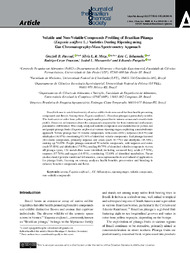Volatile and Non-Volatile Compounds Profiling of Brazilian Pitanga (Eugenia uniflora L.) Varieties During Ripening using Gas Chromatography-Mass Spectrometry Approach.
Volatile and Non-Volatile Compounds Profiling of Brazilian Pitanga (Eugenia uniflora L.) Varieties During Ripening using Gas Chromatography-Mass Spectrometry Approach.
Author(s): PASCOAL, G. B.; MEZA, S. L. R.; TOBARUELA, E. C.; FRANZON, R. C.; MASSARETTO, I. L.; PURGATTO, E.
Summary: Brazil is home to a rich biodiversity of native edible fruits renowned for their health-promoting compounds and flavors. Among these, Eugenia uniflora L. (Brazilian pitanga) is particularly notable. The fruit varies in color from yellow to purple and is prized for its intense aroma and versatile taste profile. However, information about the compounds responsible for their nutritional and sensory potential is still limited. This study analyzed volatile compounds and metabolites in yellow, red and purple pitanga fruits (Eugenia uniflora) at various ripening stages, exploiting a metabolomics approach. Yellow pitanga had 30 volatile compounds, with esters (40%), terpenes (26.67%) and aldehydes (16.67%) constituting 83.34% of identified volatile compounds. Red pitanga featured 26 volatile compounds, primarily terpenes and esters (each 30.77%) and aldehydes (15.38%), making up 76.92%. Purple pitanga contained 39 volatile compounds, with terpenes and esters (each 35.90%) and aldehydes (17.95%), totaling 89.75% of identified volatile compounds. Across all pitanga types, 124 metabolites were identified, including saturated fatty acids (17.74%), terpenes (17.74%) and sugars (16.93%), constituting 52.41% of identified metabolites. Future studies should provide nutritional information, consumption methods and industrial applications for pitanga fruits, focusing on sensory analysis, health benefits, preservation and breeding to enhance bioactive compounds and flavor.
Publication year: 2025
Types of publication: Journal article
Observation
Some of Embrapa's publications are published as ePub files. To read them, use or download one of the following free software options to your computer or mobile device. Android: Google Play Books; IOS: iBooks; Windows and Linux: Calibre.
Access other publications
Access the Agricultural Research Database (BDPA) to consult Embrapa's full library collection and records.
Visit Embrapa Bookstore to purchase books and other publications sold by Embrapa.

